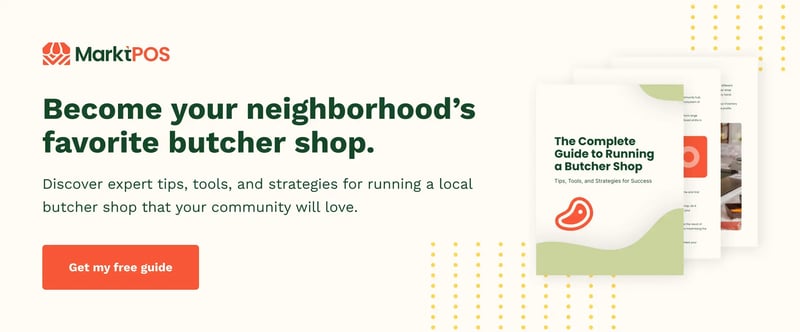7 Things To Include in Your Meat Market Business Plan
You’re passionate about protein and ready to work hard — but that’s not all it takes for meat market success.
You need a rock-solid business plan.
In this blog, we’ll explore seven essential (but often overlooked) elements of a meat market business plan, and share our top tips for curating the right product selection, nurturing a dedicated customer base, and achieving healthy profit margins.
Why You Need a Meat Market Business Plan
When it comes to starting a business, you shouldn’t leave anything up to chance. Every decision you make — from where you set up shop to the specific cuts of meat in your coolers — should be made with care.
But with so many to-dos on your list as a new business owner, it’s easy to forget a few critical ingredients for a comprehensive plan. That’s why we created this list of can’t-miss sections to include in your meat market business plan.
1. Competitive Strategy and Unique Selling Proposition
Let’s face it: You can’t compete with big-box supermarkets on price and convenience — so why should customers choose your business for their protein needs?
Your meat market business plan should give a strong answer to this question, outlining how you plan to meet customers’ needs and give them something they can’t find anywhere else.
To come up with your unique selling proposition (USP), visit other local grocery stores and butcher shops, taking note of what they do well and where they fall short.
Then, brainstorm how you’ll fill this gap. For example, you might commit to offering:
- Better customer service: Train your team to help customers choose the perfect steak for any occasion.
- Better quality: Specialize in organic, local, or grass-fed beef to stand out from other grocery stores.
- Better selection: Carry less popular, highly sought out cuts like butcher’s tenders, sirloin caps, and hanger steaks.
Knowing your USP from day one will help you stand out from the competition and build customer trust.
2. Customer Profile
Just like you should know your competitors, you need to know your customers.
You can’t please everyone with your meat market’s product selection and prices, so narrow down who your shoppers are.
For example, if you’re targeting grilling enthusiasts with money to spend, you might specialize in high-end, traditional cuts like filets, bone-in ribeye, and wagyu options.
If your carnicería will cater to the neighborhood’s Hispanic population, you might stock your coolers with pork options and premarinated meats.
Bonus tip: Your competitive and customer research should help you choose the perfect location! Look for a space that’s convenient for your ideal shopper and far enough away from your closest competitor.
3. Meat Sourcing
As a protein enthusiast, you know there’s a difference between a cheap cut from the freezer and a hand-cut steak from a local farm. Your customers can, too.
That’s why it’s so important to do your research and decide how to stock your meat market’s coolers.
Purchasing whole animals directly from a local farm is one of the best options.
While it might be more expensive than purchasing from another wholesaler, this farm-to-table approach will help you stand out from the competition, attract dedicated customers, and justify higher prices.
4. Estimated Costs
Most aspiring business owners know that financing is important, but they often struggle to estimate their startup and ongoing costs accurately.
To help you avoid unpleasant financial surprises, here’s what to budget for:
- Location: Security deposit, ongoing rent, maintenance, and utilities
- Licensing: Permit costs, filing fees, and business insurance premiums
- Renovation: Counters, tables, display cases, signage, and lighting fixtures
- Equipment: Refrigerators, freezers, hooks, saws, grinders, and knives
- Safety essentials: Pressure washers, proper cleaning solutions, personal protective equipment (PPE) for employees, and temperature control systems
- Checkout technology: Integrated deli scales, label printers, and point of sale (POS) software and hardware
- Inventory: Wholesale costs, preparation time, and storage needs
These are just a few examples of what it will cost to get your meat market up and running.
Related Read: Startup Basics for a Meat Shop: Investment, Inventory, and Tools
5. Projected Revenue and Profits
Setting prices that feel right is one of the biggest mistakes new butchers make, leading to stifled profits from day one of your meat market’s operations.
We recommend outlining your pricing strategy and projecting your revenue before making your first sale.
Use your market’s POS system to carefully track your inventory costs and product demand, and use these metrics to create a data-driven pricing strategy. For example, cuts like sirloin caps are fairly cheap to produce — but customers are willing to pay more for them.
Keep a close eye on your sales reports to make sure your pricing strategy strikes the right balance between meeting customers’ expectations and helping you achieve your profit goals.
Related Read: How To Price Meat in Your Butcher Shop: 4 Tips
6. Food Safety and Inventory Management
Proper inventory management is crucial for meat market success — which is why your business plan should include a thorough overview of how you plan to track stock levels accurately and ensure the freshness of every cut.
Our number-one recommendation is to invest in a POS system specifically designed for meat sales. This all-in-one tool should include powerful inventory management features like:
- Scale integration: Eliminate manual entry at the butcher or checkout counter by connecting your POS software and scale.
- Label printing: Offer grab-and-go options with barcode labels listing the product name, exact weight, calculated price, and package dates.
- Real-time inventory tracking: Get an overview of everything you have in stock at any time — from meats to premade sides.
- In-depth sales reporting: Learn about your customers’ shopping habits and preferences, and adjust your offerings to meet their needs.
The right tools will help you maintain proper food safety standards, like adequate labeling and first in, first out (FIFO).
7. Marketing Plan
Our final meat market business plan tip is to outline how you’ll attract and retain customers.
A smart marketing plan can save you from revenue slowdowns and help you start building a loyal customer base.
Let’s look at a few of our favorite meat marketing ideas:
- Post on social media: Create an account for your meat market to announce your grand opening, give future customers a behind-the-scenes look at your operations, and highlight your high-quality cuts.
- Offer promotions: Increase foot traffic by offering a grand opening or new customer discount. Make these promotions more cost-effective by targeting your least popular cuts.
- Create meal kits: Become a convenient dinner option by offering premarinated meats and premade sides.
- Sell online: Save customers time and expand your reach by embracing e-commerce. You can offer convenient pickup and delivery services.
- Start a loyalty program: Reward customers every time they shop with you, letting them earn loyalty points and exchange them for future discounts.
Good meat sells itself — but you still need to encourage customers to give your market a try. Use these strategies to boost foot traffic and keep shoppers coming back.
Achieve Meat Market Success With Markt POS
Ready to bring your meat market business plan to life? We can help!
Markt POS, our all-in-one POS system, is specifically designed to help you launch, manage, and grow a thriving meat market. You’ll enjoy smooth operations, happy customers, and more sales with features like weight-based meat inventory management, in-depth sales reporting, seamless e-commerce integration, and built-in marketing tools.
See how Markt POS fits into your meat market business plan by scheduling a personalized demo with one of our experts today.







 by Joel
by Joel

 by Luke
by Luke
